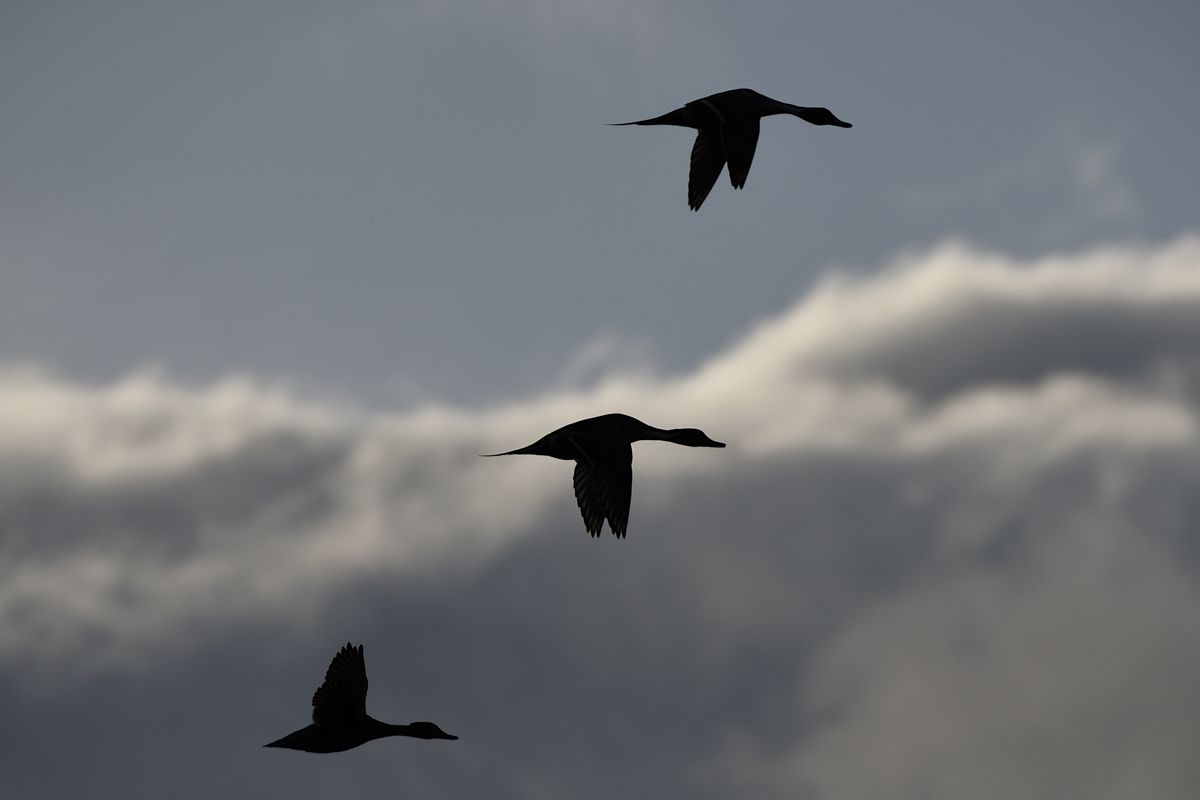Saltese Flats has gone from ag land to birding mecca in a few short years

One wigeon gets the wave started.
The skittish duck floating among dozens takes flight first. Two follow, then 10 more and, a half-second later, they’ve all lifted off in a storm of flashing white wings and sparkling water droplets.
Migrating waterfowl, hundreds and thousands of them, are a common and beautiful spring sight at the Saltese Flats Wetland Area west of Liberty Lake and east of Barker Road.
In just a few years, Saltese Flats has gone from a small, private pond surrounded by agricultural land to a publicly accessible, recovering wetland ecosystem. Its water levels fluctuate throughout the year, and the site is well-known among local bird watchers. Birders have seen 194 species at Saltese Flats, which puts the area behind only Turnbull National Wildlife Refuge, Eloika Lake and Philleo Lake among Spokane County birding hot spots.
It’s been a dramatic change.
Before the 1890s, the site was often full of water. Farmers drained it before the turn of the century, and for more than a hundred years it was mostly hayfields.
In 2010, Spokane County started acquiring the property. The 500-plus-acre acquisition serves a dual purpose. It was always going to be a conservation project but it was, and is, an insurance policy, too. If the county’s ever forced to stop discharging wastewater into the Spokane River, it’ll likely start pumping treated water 15 miles to Saltese Flats instead.
Over the past decade, Spokane County and conservation groups have made major investments at Saltese Flats. The area has been opened to the public and ecologically transformed.
Three years ago, the county began installing a trail system. There’s a parking lot now. The county built a water control system.
“We’re putting the water on there on purpose and trying to hold it as long as we can,” Spokane County Water Reclamation Engineer Ben Brattebo said.
A $2 million learning center is under construction, atop a hill on the north end of the site. It should be completed by early next year. The center will include classrooms, teach visitors about wetlands wildlife and give people an opportunity to look out over the area. Benches, signs and more trails improvements are on the way.
In addition to the accessibility changes, a restoration effort, funded by a handful of sources, is aimed at returning Saltese Flats to its natural state.
Birders say all the improvements are welcome. There’s now an easily accessible wildlife refuge close to town, where before there was just a small pond and hayfields.
“I give kudos to the county,” birder Tim O’Brien said. “The Saltese was not a Spokane birding destination 10 years ago.”
O’Brien emphasized how much Saltese Flats has changed since 2019 following the construction of a trail system.
“They opened the whole area to public access,” he said. “And whammo, that just let us get out there and see what’s there, and that’s been amazing.”
In winter and early spring, thousands of waterfowl visit the wetland, covering the water with a smorgasbord of ducks, geese and swans. Saltese Flats is a pit stop for many species that breed in Canada.
“When the water’s there is definitely the time to be there,” O’Brien said.
Chris Bonsignore, manager of conservation programs for Ducks Unlimited, estimated there were 10,000 to 20,000 waterfowl at Saltese Flats when migration peaked two weeks ago.
Northern pintails, American wigeons and mallards are the most abundant ducks. Hundreds of elegant tundra swans stop over, too.
Migrating shorebirds, which often hang out on the muddy edges by the water, start to show up later in spring, O’Brien said.
“My excitement is, what are we going to find here come late April, early May?” he said. “It’s a treasure hunt now that we have great habitat for shorebirds.”
Late spring and early summer are a slow time at Saltese Flats. Most of the water has drained into the ground and Saltese Creek by that point, leaving the wetlands dry except for two small ponds. Only the nesting species remain, including western meadowlarks and several species of sparrow.
By mid-August, the fall migration begins. That’s an exciting time for birders, too, O’Brien said. It’s common to find “rarities” – species that typically wouldn’t migrate through Eastern Washington but have lost their way.
Late fall and winter are quieter times at the wetland, although O’Brien said he had the opportunity to see short-eared owls in 2021, hunting over ground that’s covered in water for part of the year.
As habitat restoration efforts continue, Saltese Flats should become an even better place for birds.
Bonsignore said Ducks Unlimited and the county have spent the last couple of years trying to eradicate reed canary grass, an invasive species that had taken over much of the wetlands.
Removing the reed canary grass and flooding the ground has allowed native plants to come back, Bonsignore said. In many areas, Ducks Unlimited didn’t need to put down fresh seed – plants sprouted to life from the dormant seed bank.
Seeding efforts have taken place as well, helped by several grants, and Bonsignore said Ducks Unlimited is planting dogwood, willow and cottonwood. The shrubby dogwood and willow, and the cottonwood trees, will increase habitat diversity.
Bonsignore said that to help waterfowl, it’s important to have healthy ecosystems.
“We want to restore the ecosystem to as close to natural as we can get it,” he said.
The restoration effort has just begun, Bonsignore said. As native plants return and the county ensures consistent seasonal flooding, the landscape will change.
“We’re very early on in the process,” Bonsignore said. “In five or six years, this is going to look very different.”
Editor’s note: This story has been updated to correct the spelling of Chris Bonsignore’s name.